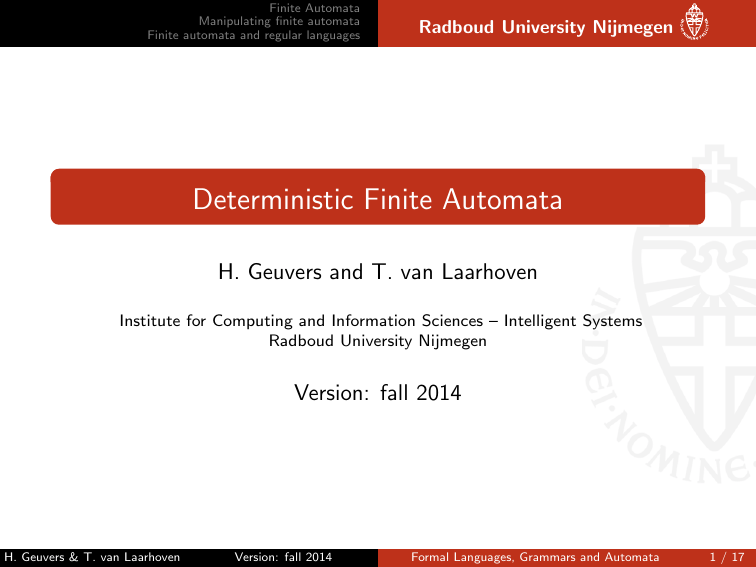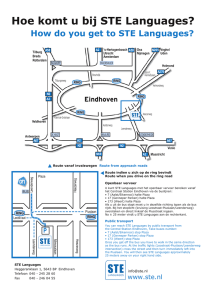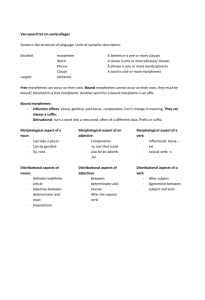Algemene voorwaarden Boksfit

Finite automata and regular languages
Radboud University Nijmegen
Deterministic Finite Automata
H. Geuvers and T. van Laarhoven
Institute for Computing and Information Sciences – Intelligent Systems
Radboud University Nijmegen
Version: fall 2014
H. Geuvers & T. van Laarhoven Version: fall 2014
Formal Languages, Grammars and Automata
1 / 17
Outline
Finite automata and regular languages
Radboud University Nijmegen
Finite automata and regular languages
H. Geuvers & T. van Laarhoven Version: fall 2014
Formal Languages, Grammars and Automata
2 / 17
Finite automata and regular languages
Radboud University Nijmegen
Deterministic Finite State Automaton (DFA)
Intuition. Let Σ = { a , b } . Consider the DFA M : a , b a start q
0 b a q
1 b q
2
Letters a , b are the moves in the graph
A w ∈ Σ
∗ is a sequence of moves
Start state is indicated by ‘start → ’,
Accepting states by double circle
(there can be several accepting states)
The word abba is accepted , but baab is not accepted (rejected)
M = ( Q , q
0
, δ, F ) with Q = { q
0
, q
1
, q
2
} , F = { q
2
} and δ given by
δ a b q
0 q
0 q
1 q q
1
2 q
0 q
2 q q
2
2
H. Geuvers & T. van Laarhoven Version: fall 2014
Formal Languages, Grammars and Automata
4 / 17
Finite automata and regular languages
Radboud University Nijmegen
Deterministic Finite Automata formally
M is a DFA over Σ if M = ( Q , q
0
, δ, F ) with
Σ is a finite alphabet
Q q
0
∈ Q
F ⊆ Q is a finite set of is the initial states state is a finite set of final states
δ : Q × Σ → Q is the transition function
Reading function δ
∗
(often given by a table or a transition diagram)
: Q × Σ
∗
→ Q (multi-step transition)
δ
∗
( q , λ ) = q
δ
∗
( q , a ) = δ ( q , a )
δ
∗
( q , aw ) = δ
∗
( δ ( q , a ) , w )
The language accepted by M , notation L ( M ), is:
L ( M ) = { w ∈ Σ
∗
| δ
∗
( q
0
, w ) ∈ F }
H. Geuvers & T. van Laarhoven Version: fall 2014
Formal Languages, Grammars and Automata
5 / 17
Finite automata and regular languages
Reading words w ∈ Σ
∗
Radboud University Nijmegen
Computation for δ
∗
( q
0
, w ) in the example DFA. Take w = abba :
[ q
0
, abba ] ` [ δ ( q
0
, a ) , bba ] = [ q
0
, bba ]
` [ δ ( q
0
, b ) , ba ] = [ q
1
, ba ]
` [ δ ( q
1
, b ) , a ] = [ q
2
, a ]
` [ δ ( q
2
, a ) , λ ] = [ q
2
, λ ]
[ q
0
, aba ] ` [ δ ( q
0
, a ) , ba ] = [ q
0
, ba ]
` [ δ ( q
0
, b ) , a ] = [ q
1
, a ]
` [ δ ( q
1
, a ) , λ ] = [ q
0
, λ ]
So abba is acepted and aba is not accepted.
The language accepted by M (of the first slide) is regular. It is the language
L (( a + b )
∗ bb ( a + b )
∗
) .
H. Geuvers & T. van Laarhoven Version: fall 2014
Formal Languages, Grammars and Automata
6 / 17
Finite automata and regular languages
Radboud University Nijmegen
From transition table to state diagram
Consider the automaton M over Σ = { a , b } with
• Q = { 0 , 1 , 2 , 3 , 4 } ,
•
• q
0
= 0,
F = { 4 }
•
δ a b
0 1 0
1 1 2
2 1 3
3 4 0
4 4 4
1
2
3
Which of the following words is accepted?
abba , baba , bba
Is it the case that { w | | w | b is even } ⊆ L ( M )?
Is it the case that { w | w contains aabbaa } ⊆ L ( M )?
H. Geuvers & T. van Laarhoven Version: fall 2014
Formal Languages, Grammars and Automata
7 / 17
Finite automata and regular languages
Radboud University Nijmegen
Manipulating Finite Automata: products for intersection start start a
0 b
M a a b p a start 0 , p b b a a
0 , q a
1 , p
1 , q b
1 a,b q b b
L ( M )
L
1
= { w | | w | a is even }
L
2
= { w | | w | b
≥ 1 }
L
1
∩ L
2
=
{ w | | w | a is even and | w | b
≥ 1 }
H. Geuvers & T. van Laarhoven Version: fall 2014
Formal Languages, Grammars and Automata
9 / 17
Finite automata and regular languages
Product of two DFAs
Radboud University Nijmegen
Given two DFAs over the same Σ
M
1
M
2
=
=
(
(
Q
Q
1
2
, q
01
, q
02
, δ
1
, F
1
)
, δ
2
, F
2
)
Define
M
1
× M
2
= ( Q
1
× Q
2
, q
0
, δ, F ) with
Then with
F := F
1
× F
2
:= { ( q
1
, q
2
) | q
1
∈ F
1 and q
2
∈ F
2
} we have q
0
:= ( q
01
, q
02
)
δ (( q
1
, q
2
) , a ) := ( δ
1
( q
1
, a ) , δ
2
( q
2
, a ))
L ( M
1
× M
2
) = L ( M
1
) ∩ L ( M
2
)
H. Geuvers & T. van Laarhoven Version: fall 2014
Formal Languages, Grammars and Automata
10 / 17
Finite automata and regular languages
Closure Properties
Radboud University Nijmegen
Proposition Closure under complement
If L is accepted by some DFA, then so is
L = Σ
∗
− L .
Proof.
Suppose that L is accepted by M = ( Q , q
0
, δ, F ).
Then L is accepted by M = ( Q , q
0
, δ, F ).
-
Proposition Closure under intersection and union
If L
1
, and L
2 are accepted by some DFA, then so are L
1
∩ L
2 and
L
1
∪ L
2
.
Proof.
For the intersection, this follows from the product construction on the previous slide.
For the union, this can be seen by the product construction, taking a different F (which one?) or by noticing that L
1
∪ L
2
= L
1
∩ L
2
.
-
H. Geuvers & T. van Laarhoven Version: fall 2014
Formal Languages, Grammars and Automata
11 / 17
Finite automata and regular languages
Kleene’s Theorem
Radboud University Nijmegen
Theorem The languages accepted by DFAs are exactly the regular languages
We will prove this in this and the next lecture by
1
If L = L ( M ), for some DFA M , then there is a regular expression e such that L = L ( e ) (this lecture).
2
3
If L = L ( e ), for some regular expression e , then there is a non-deterministic finite automaton (NFA) M such that
L = L ( M ). (next lecture).
For every NFA M , there is a DFA M
L ( M ) = L ( M
0
) (next lecture)
0 such that
H. Geuvers & T. van Laarhoven Version: fall 2014
Formal Languages, Grammars and Automata
12 / 17
Finite automata and regular languages
Radboud University Nijmegen
From DFAs to regular expressions
Given the DFA M = ( Q , q
0
, δ, F ), we construct a regular expression e such that
L ( e ) = L ( M ) .
Procedure:
• We remove states, replacing symbols from Σ by words from Σ
∗
,
• until we end up with a “simple automaton” from which we can read off e .
H. Geuvers & T. van Laarhoven Version: fall 2014
Formal Languages, Grammars and Automata
14 / 17
Finite automata and regular languages
Simple automata
Radboud University Nijmegen start start u q
0 start
M w q
0 w q
0 x y start u q
0 x y v q
1 v q
1 e such that L ( e ) = L ( M ) w
∗ u
∗
( u +
0 xv
∗ y ) x ( v + yu
∗
∗ x )
∗
H. Geuvers & T. van Laarhoven Version: fall 2014
Formal Languages, Grammars and Automata
15 / 17
Finite automata and regular languages
Eliminating states
Radboud University Nijmegen
•
•
Remove a state p , while adding arrows q → q
0 between other pairs of states.
Before: v q x p y q
0
After: xv
∗ y q p q
0
H. Geuvers & T. van Laarhoven Version: fall 2014
Formal Languages, Grammars and Automata
16 / 17
Finite automata and regular languages
Special cases
Join arrows using + x q q
0 y
First create a single final state
Radboud University Nijmegen q x + y q
0 q q
0
λ p
λ q q
0
Beware of loops v x q p y q xv
∗ y p
H. Geuvers & T. van Laarhoven Version: fall 2014
Formal Languages, Grammars and Automata
17 / 17


